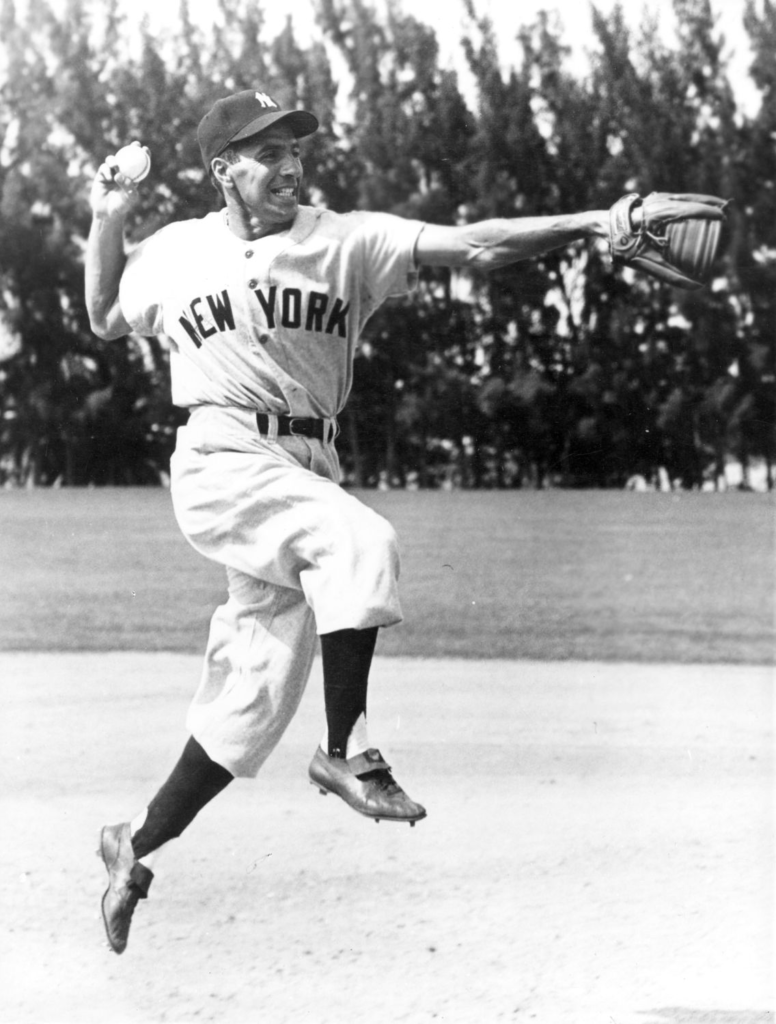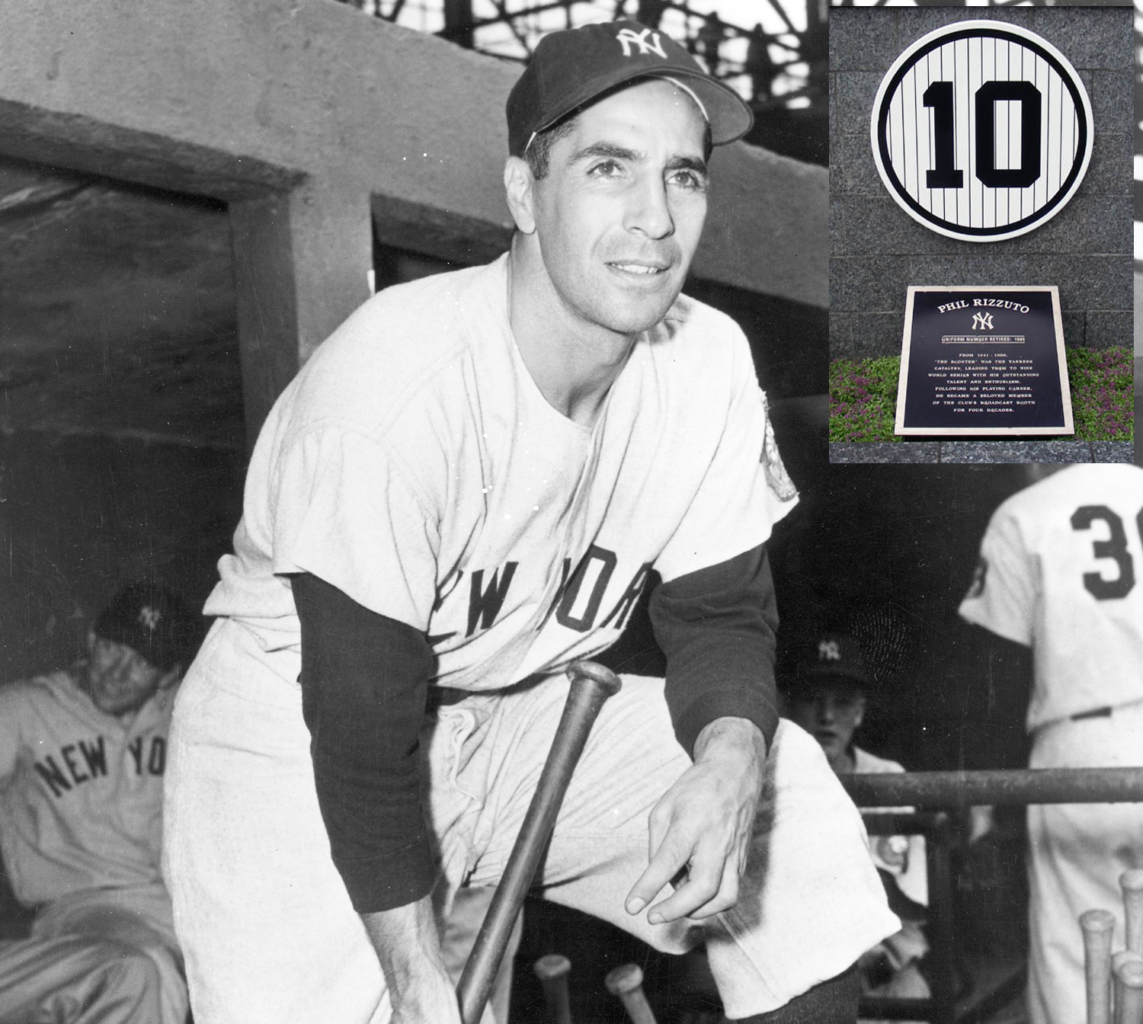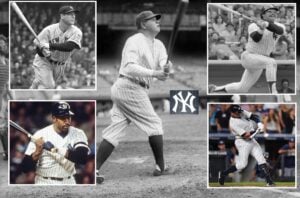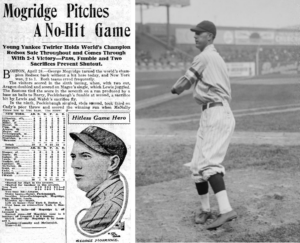Remembering Yankees No. 10, ‘The Scooter’ Phil Rizzuto

Jeremiah Dobbs
More Stories By Jeremiah Dobbs
- Mother’s Day: How Anthony Volpe’s mom molded him into a Yankee phenom
- 470-Foot Bomb: Aaron Judge sets career record despite Yankees’ loss to Red Sox
- Giancarlo Stanton to rejoin Yankees for Phillies series opener on Monday
- Yankees’ prospect Jasson Dominguez hits 1-for-4 in Triple-A comeback
- Rich Hill draws Yankees’ attention for midseason signing
- August 4, 2023
- 12:59 pm
- 3 Comments
Table of Contents
Thirty-eight years ago, on August 4, 1985, the Yankees retired their No. 10 shirt to honor Phil Rizzuto in a packed ceremony at Yankee Stadium. The shortstop, also fondly called “The Scooter,” played for the New York Yankees for all 13 years of his career, from 1941 to 1956. After he stopped playing, he became a broadcaster and was very popular for his pro-Yankee stand. He would add fun things to his commentary, like wishing fans a happy birthday and saying “Holy cow!” when something exciting happened during the game.
Phil Rizzuto got into the National Baseball Hall of Fame in 1994. He was part of the Yankees team that won five World Series titles in a row from 1949 to 1953 and then again in 1955.
In 1950, he had his best season ever and even won the Most Valuable Player award for the American League. He was amazing at bunting the ball and was super skilled at playing defense. He was part of the Yankees when they won 10 American League pennants and nine World Series championships. He was also on the team that won five World Series in a row from 1949 to 1953.
It was not easy for him to become a Yankee

Philip Francis Rizzuto, one of five children of Rose and Fiore Rizzuto, grew up in Brooklyn and later moved to Glendale, Queens when he was 12. He attended Richmond Hill High School and even tried out for the Dodgers. However, their manager, Casey Stengel, told him he was too small to play baseball. Phil Rizzuto also faced rejection from the New York Giants. But Stengel’s rejection stood out the most, as he famously told him to “go get a shoeshine box.”
Phil Rizzuto signed a contract with the Yankees in 1937, and they assigned him to their Class D minor league team in Bassett, Virginia. He later mentioned that when Casey Stengel became the Yankee manager in 1949, he reminded him of that situation, but Stengel pretended not to remember. Phil Rizzuto added that by 1949, he didn’t need a shoebox anymore and the clubhouse boy at Yankee Stadium took care of shining his Yankee spikes every day.
In 1941, when Phil Rizzuto showed up for spring training with the Yankees, his small stature made pitcher Lefty Gomez question why the team had called in a “Lilliputian.” However, Phil Rizzuto quickly proved himself by replacing the veteran Frank Crosetti and achieving a batting average of.307 in his rookie season.
However, just because he took over for the well-liked Frank Crosetti doesn’t mean that being a Yankee was easy for him. Some players even tried to prevent him from using the batting cage, but Joe DiMaggio stepped in and instructed them to let Phil Rizzuto have his turn at hitting.
Phil Rizzuto became a cornerstone of the Yankees’ infield, creating strong double-play duos with second basemen Gerry Priddy, Joe Gordon, and Jerry Coleman (who would later join Rizzuto in the broadcast booth during the 1960s). He also embraced his unique quirks—he was humorous, superstitious, had a fear of thunder, and was often the target of playful pranks. In the past, players left their gloves on the field when they went up to bat, and Rizzuto would sometimes discover a surprise like a mouse, snake, or rat stuffed inside the glove fingers when he returned to the field.
Phil Rizzuto’s successful Yankees career
During his illustrious 13-season career, Phil Rizzuto left an indelible mark on World Series history, holding numerous records for shortstops. The pinnacle of his achievements came in the 1950 season when he was crowned the American League’s Most Valuable Player. Renowned for his masterful bunting skills and defensive prowess, Phil Rizzuto played a crucial role in guiding his teams to an astounding 10 American League pennants and seven World Series championships.

A remarkable feat in his career was being part of the legendary Yankees squad that accomplished the rare feat of five consecutive World Series triumphs from 1949 to 1953. Upon retiring, he ranked second in major league history for career double plays turned, boasting an impressive tally of 1,217, trailing only Luke Appling’s record of 1,424. Additionally, his outstanding career fielding average of .968 placed him second among AL shortstops, trailing only Lou Boudreau’s remarkable mark of .973. Rizzuto’s legacy as a skilled defensive specialist and vital contributor to the Yankees’ unprecedented success continues to be celebrated in baseball history.
Though he was a short guy, only 5 feet 6 inches tall, and weighed 150 pounds, Phil Rizzuto was full of energy and did things perfectly, like making a quick turn to get a double play or doing a great job with a sacrifice bunt. He let his big teammates like Joe DiMaggio, Mickey Mantle, Tommy Henrich, Charlie Keller, and Yogi Berra do the heavy hitting.
DiMaggio, one of the game’s great centerfielders, mentioned that the small guy in front of him made his job easy, as he didn’t have to pick up as many ground balls.
Phil Rizzuto’s two most memorable games
Two specific plays in 1951 stood out as symbols of Phil Rizzuto’s career. In one instance, which took place in 1951, the shortstop found himself in a significant situation. He was facing Bob Lemon of the Cleveland Indians while at bat (despite being a right-handed batter). This occurred during the bottom of the ninth inning, a crucial moment in the race for the pennant. The game was tied at 1 run apiece, and Joe DiMaggio was positioned on third base. Phil Rizzuto decided to let Lemon’s first pitch go by, even though the umpire called it a strike.
This led to a brief disagreement with the umpire. This pause allowed Phil Rizzuto to adjust his grip on the bat, which signaled to DiMaggio that they would attempt a squeeze play on the next pitch. Unexpectedly, DiMaggio began his dash toward home base early, catching Phil Rizzuto off guard. Recognizing the situation, Lemon adjusted his pitch to aim high and away from Phil Rizzuto, attempting to avoid a successful bunt. However, despite the challenging circumstances and with DiMaggio rapidly approaching, the Yankees’ scooter managed to lift his bat and execute a bunt.

Phil Rizzuto explained that if he hadn’t attempted the bunt, the pitch would likely have struck him in the head. He managed to bunt the ball with both feet off the ground, directing it toward first base. As a result of his play, DiMaggio successfully scored the winning run. Stengel described it as the most exceptional play he had ever witnessed.
In the same year, during Game 3 of the World Series against the New York Giants, Phil Rizzuto encountered an opponent who would become a source of frustration for him throughout his life. In the fifth inning with one out, Eddie Stanky from the Giants drew a walk against the Yankees’ pitcher Vic Raschi. The next batter was Alvin Dark, and the Yankees figured out that a hit-and-run play was in the works. Yogi Berra, the catcher, signaled for a pitchout, and his throw to Phil Rizzuto at second base easily reached ahead of Stanky by a wide margin.
However, as Phil Rizzuto held the ball in his glove, Stanky slid and managed to kick the ball away with his right foot, causing it to roll into center field. Stanky then made his way to third base. Phil Rizzuto was given an error, and as a result, the Giants capitalized on the mistake and scored five runs that were considered unearned.
Phil Rizzuto’s abrupt retirement

Phil Rizzuto was with the Yankees from 1941 to 1956. However, his departure from the team happened suddenly. The team decided to let him go on Old-Timers’ Day, as they no longer wanted to keep an older infielder who wasn’t getting much playing time. This decision surprised Phil Rizzuto, especially when the Yankees released him in 1956 to sign Enos Slaughter, an outfielder. Despite the initial shock, he found a new role as a broadcaster for Yankee radio and TV broadcasts, a position he held until 1996.
During his more than forty years in the Yankees’ announcing booth, Phil Rizzuto changed from being a regular announcer with a clear New York accent to someone who often brought humor to his broadcasts. His fame spread beyond New York as well. The comedian Billy Crystal imitated him, and even Meat Loaf incorporated Phil Rizzuto’s broadcast voice in his popular song “Paradise by the Dashboard Light,” which came out in 1978.
Regarding his well-known saying, “Holy cow,” he mentioned that he started using it during high school on the advice of his baseball coach, as a way to avoid using inappropriate language. In 1985, when the Yankees honored Phil Rizzuto with a special day to celebrate his contributions and retired his jersey number 10, they also gave him a cow as a gift. However, the cow accidentally stepped on his foot and knocked him over during the ceremony.
After numerous years of not being selected for the Hall of Fame in Cooperstown, New York, he was finally chosen in 1994. Phil Rizzuto passed away on August 13, 2007, at the age of 89, due to pneumonia.
How do you rate Phil Rizzuto among the Yankees legends? Leave your comment below.
- Categories: phil rizzuto, Yankees legends, Yankees shortstop
- Tags: phil rizzuto, Yankees legends, Yankees shortstop



 Follow Us
Follow Us










3 thoughts on “Remembering Yankees No. 10, ‘The Scooter’ Phil Rizzuto”
Scooter was a true folk heroe, even part of a Meatloaf song. Player, announcer, broadcaster, he enriched several generations of Yankee fans.
My friend Dan and I were at that game and the Holy Cow he was given, knocked him down. His day unfortunately was overshadowed by Tom Seaver’s 300th win while pitching that day for the White Soxs.
The Scooter forever ♾️
I grew up listening to him. He was to me what Mel Allen was to my Dad.